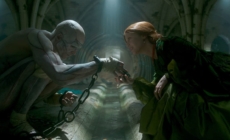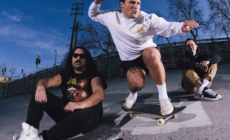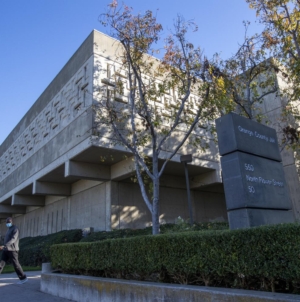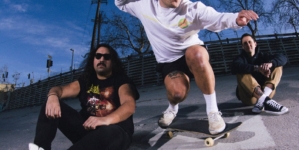-
Volley of gunshots at L.A. apartment leads to 8-hour SWAT standoff - 24 mins ago
-
Frankenstein Ending Explained | What Happened to the Creature? - 28 mins ago
-
Epstein Bantered Regularly With Larry Summers - 37 mins ago
-
‘Candy’ for Your Ears: The Uniquely Human Sound of DRAIN - about 1 hour ago
-
Mega Millions jackpot jumps to $965 million for Friday’s drawing - about 1 hour ago
-
City Council Approves Plan That Could Bring 14,700 Homes to Queens - about 1 hour ago
-
WWE Insider Shuts Down John Cena’s Final Match Rumors - 2 hours ago
-
Feds charge Gov. Newsom’s former chief of staff over alleged fraud, tax crimes - 2 hours ago
-
‘A Lot of Uncertainty’ Suddenly Surrounds a Storm Hitting California - 2 hours ago
-
Trump Admin Plans Major Student Visa Change - 2 hours ago
An intertribal commission will co-manage Chuckwalla National Monument
Chuckwalla National Monument is more than an epic expanse of towering rocks, hidden canyons, ghost flowers, smoke trees and its namesake lizard. One of America’s newest protected public lands is a birthplace, a crossroads, a beloved relative and a historical document to the tribes of the California desert.
Stretching across 624,000 acres from the Coachella Valley to the Colorado River at the state’s border with Arizona, this landscape possesses a spirit and energy that flow through every object, every living thing and every molecule of air within it, according to tribal members.
When an ecosystem is so ingrained in your psyche, so essential to your culture and so central to the stories you tell about your reason for being, you have no choice but to safeguard it.
This is the galvanizing sentiment behind the recent creation of an unprecedented commission for California that brings together five tribes to advise the U.S. government on the management of a monument that holds specific meaning to each and is a treasure to all.
The Torres Martinez Desert Cahuilla Indians, the Fort Yuma Quechan Indian Tribe, the Cahuilla Band of Indians, the Chemehuevi Indian Tribe and the Colorado River Indian Tribes each have passed resolutions recognizing their role on the commission. Processes to appoint commission members and write bylaws started this fall.

“Tribal Nations, including the members of the Commission, have been connected to this landscape since time immemorial and will continue to steward this landscape into the future,” said Daniel Leivas, chairman of the Chemehuevi Indian Tribe.
(Chemehuevi Indian Tribe)
“Rather than be in conflict, there is mutuality,” said Daniel Leivas, chairman of the Chemehuevi. “The forming of this commission is a testament to a willingness to come together for the same purpose: for the future of our children and for our ancestors.”
Ordinarily, the establishment of a land use panel — one with no veto power at that — would not be considered historic or particularly memorable. But given the grim history of Native peoples’ encounters with the U.S. government — forced removal from ancestral territories, treaties undermined by unscrupulous lawmakers in Washington, cultural erasure and genocide — this commission holds special significance, especially for its founders.
It offers a high-profile platform not just to advocate for the land but to speak truth about the different Native people who feel kin to it.

The Ladder and Painted Canyon Trail inside Chuckwalla National Monument, a protected area in Southern California established in January 2025 by President Biden.
(Tecpatl Kuauhtzin / For The Times)
For millennia, these nomadic tribes traversed the area to trade with each other and set up settlements in sync with the seasons.
The Cahuilla people believe they originated among the red walls and leaning stone outcroppings of the Painted Canyon, and burial grounds throughout the site attest to its sacred place in their culture.
The Chemeheuvi believe that its streams carry the memories of their ancestors.

Fort Yuma Quechan Chairman Zion White, a newly appointed Chuckwalla commissioner, feels it’s his duty to carry on the work of his elders who’ve been fighting for generations to assert their cultural connection to that ecosystem.
(Fort Yuma Quechan Indian Tribe)
Quechan “lightning songs” directly reference locations contained within Chuckwalla’s borders, said Zion White, a Quechan cultural singer.
“I talk about those places when I sing those songs,” said White, who was recently selected to represent his tribe on the commission.
Modeled in part on the intertribal commission set up to protect Bears Ears National Monument in Utah, the Chuckwalla commission was mandated in President Biden’s January proclamation establishing the monument. The commission will have direct contact with the federal Bureau of Land Management.
“It’s really an acknowledgment of that sovereignty that we possess as tribes, to be able to come together and have this body that directly engages with the federal government,” he said.

Chuckwalla National Monument is an epic expanse of towering rocks and hidden canyons.
(Tecpatl Kuauhtzin / For The Times)
The commission takes shape at a pivotal moment, as the Trump administration has asserted its right to reverse national monument proclamations, calling out Chuckwalla National Monument by name. The administration has also pared down the size and regulatory authority of environmental agencies, and has acted to open more protected public lands and marine areas to natural-resource extraction and other potentially harmful activities.
Indeed, the lands immediately surrounding Chuckwalla have seen an onslaught of housing, tourism and extraction projects in recent years.
The tribal leaders say they have no illusions about the influence of the commission. Co-stewardship is not the same as control — which is the promise and aim of tribes that reclaim ancestral territories through “land back” agreements.
Even so, the monument and commission mark a step forward, said Bennae Calac, director of tribal engagement for the Chuckwalla monument campaign and a member of the Pauma Band of Luiseño Indians.

Michael Madrigal, the president of the Native American Land Conservancy and a citizen of the Cahuilla Band of Indians.
(Cierra Breeze / Idyllwild Arts)
Calac was instrumental in bringing the desert tribes together to push for the proclamation and craft the language for it — one of the few examples of Native Americans anywhere in the U.S. taking the lead on a monument effort.
“What’s happened with this administration, it doesn’t matter to the tribes,” Calac said. “They’re going to use their sovereignty and their power to continue to care for the land, whether it’s this administration or the next. That’s what the tribes have always done historically. We just want an administration that’s going to work with us.”
This clear-eyed realism is characteristic of Native people in this state on both land stewardship and the federal government, said Brittani Orona, a Hupa environmental and public humanities scholar and assistant professor of Native American Studies at UC Davis.
Having previously worked on crafting other co-stewardship agreements while at California State Parks, Orona said she’s interested to see how the Chuckwalla commission’s relationship with the U.S. government plays out.
Given the emotional burden of partnering with a government that tried to eliminate you, and given the federal restrictions that have long kept Indigenous people from accessing or using federal lands for cultural purposes, “generally, land back is the goal,” Orona said.

A field of wildflowers in Chuckwalla National Monument, with the Mule Mountains in the background.
(Bob Wick)
“Co-stewardship isn’t perfect,” said Orona, who is not involved with the coalition that advocated for Chuckwalla or the commission. “It’s something that’s been forced upon us to think about. But people use it to great effect.” The successful tribe-led campaigns for Bears Ears, Chuckwalla and the recently designated Sáttítla National Monument in Northern California — with a combined area of more than 2.2 million acres of ancestral lands — are prime examples, she said.
For tribes directly linked to Chuckwalla, the emphasis now is on cementing a healthier relationship with the government and fortifying their bond with the land.
“There has been a lot of loss for Native nations, having places taken from us,” said Mike Madrigal, a citizen of the Cahuilla Band of Indians and president of the Native American Land Conservancy. “This monument designation goes a long way toward repairing [that damage].”

“The Chuckwalla National Monument is more than a habitat filled with trees, plants, and wildlife; for the Torres Martinez Desert Cahuilla Indians, it embodies life itself, and we are intrinsically linked to it, committed to safeguarding it,” said Joseph Mirelez, chairman of the Torres Martinez Desert Cahuilla Indians.
(Torres Martinez Desert Cahuilla Indians)
The reservation of the Torres Martinez tribe of the Cahuilla band abuts the Chuckwalla monument in the date palm-studded hub of Thermal. Tribal Chairman Joseph Mirelez described his people’s relationship to this desert, the Santa Rosa Hills and the adjacent Salton Sea as tangible. You can see it in the remains of ancient fish traps and fire pits that dot the area where the shores of the sea once stood before it shrank, and in the vertiginous box canyons inside Chuckwalla.
An outsider might view the bands of red that give the Painted Canyon its name as simply one of Chuckwalla’s abundant geological wonders. Mirelez sees in those hues the blood spilled by Mukat, a key figure in the tribe’s origin story who was exiled there.
“We can physically see where we come from and we know where we’ve been — we’re reminded of it all the time,” Mirelez said. “The good thing about the intertribal commission is that we all share the same types of stories.”
This coalition among interconnected cultures that hold one another in mutual high regard gives the commission a kind of weight that may be hard for an outsider to appreciate but is crucial to understanding how Indigenous Californians operate as governing entities.
We’re going in this as sister tribes, as brother tribes, and we’re making decisions as a collective.
— Joseph Mirelez, chairman of the Torres Martinez Desert Cahuilla Indians.
“The tribes in Southern California — we get minimal resources from the feds, so we have to maximize those resources,” Mirelez said. “That’s how we’re used to operating. We’re going in this as sister tribes, as brother tribes, and we’re making decisions as a collective.”
“Will we always agree? Obviously not,” he said. “But at least we understand what the collective is trying to accomplish, and that makes it easier.”
Too often, Mirelez said, the needs of tribes are unfairly portrayed as standing in conflict with the priorities of other Californians, such as economic development and job creation in neighboring non-Native communities.
“I’m not anti-development, but I think it depends on what the cost is,” Mirelez said. “If there’s a burial site — we’ve got to figure out how to work around that. So it’s good that we have a tribal lens to look at stewardship of it to make sure that we’re protecting our assets — our cultural artifacts and our stories.”
The people who joined forces to pushed for, and who will sit on the commission, are all part of a “cycle of creation that has been forged from time immemorial,” Chemehuevi Chairman Leivas said when explaining the traditional beliefs of the Nüwü, as his people often refer to themselves.
“Now that’s a Nüwü spiritual way of looking at things, as opposed to this materialist representation of monetary wealth and consumption and greed.”
Mirelez views the establishment of the commission as a beginning rather than an end unto itself. Although the commission is still in its early stages, he said that all of the involved tribes agree on what they’d like to achieve in the future.
“We all have the same vision — we want full management of Chuckwalla,” Mirelez said.
“It’s just figuring out when the time is right to get that accomplished.”
Source link





















